Science and Technology - 4 | Current Affairs & Hindu Analysis: Daily, Weekly & Monthly - UPSC PDF Download
Allotropes of Carbon
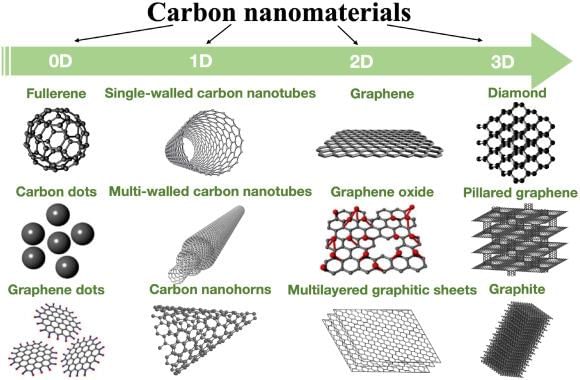 Why in News?
Why in News?
Carbon and its allotropes continue to be significant in discussions due to their diverse physical and chemical properties. An allotrope is defined as one or more forms of a chemical element that exist in the same physical state. Carbon primarily exhibits four main allotropes: Diamond, Graphite, Fullerenes, and Graphene. Additionally, less commonly recognized forms such as carbon nanotubes and amorphous carbon (like charcoal) are also considered variations of carbon.
Key Takeaways
- Carbon has four primary allotropes: Diamond, Graphite, Fullerenes, and Graphene.
- Carbon nanotubes and amorphous carbon are additional forms but are not typically classified as primary allotropes.
Additional Details
- Graphite: In graphite, each carbon atom forms bonds with three other carbon atoms, resulting in two-dimensional sheets. It consists of layers of carbon atoms arranged in hexagonal patterns.
- Electricity Conduction: Graphite is a good conductor of electricity due to the presence of delocalized electrons within its layers.
- Lubricant: The layers of graphite can easily slide over one another, making it useful as a solid lubricant.
- Hardness: Graphite is recognized as the softest allotrope of carbon.
- Graphene: Graphene is a single layer of graphite that is only one atom thick. It has significant potential in various applications, including electronics, energy storage, sensors, coatings, composites, and biomedical devices.
- Its high surface area and biocompatibility make it ideal for drug delivery and tissue engineering.
- Diamond: Diamond consists of a three-dimensional network of carbon atoms arranged in a tetrahedral structure, where each atom bonds with four other carbon atoms.
- It is known as the hardest naturally occurring material, making it suitable for industrial cutting, drilling, and grinding applications.
- Transparency: Some diamonds exhibit high transparency in the visible spectrum, making them highly valued in jewelry.
- Thermal Conductivity: Diamonds have excellent thermal conductivity, which is useful in heat sinks, but they lack electrical conductivity in their pure form due to the absence of free electrons.
- Lab-grown Diamonds (LGDs): These diamonds are identical to natural diamonds in properties such as hardness, sparkle, and durability but are created artificially in laboratories using graphite as a seed material.
- Fullerene: Buckminsterfullerene is a type of fullerene with the formula C60 and is characterized by a unique cage-like structure resembling a football.
- Applications: Fullerenes and their compounds have potential in various fields, including semiconductors, superconductors, lubricants, catalysts, electric wires, and reinforcing fibers in plastics.
- Carbon Nanotubes: These are cylindrical structures made from rolled-up graphene sheets.
- Uses include electronics, materials science, energy storage, medical applications, sensors, water purification, aerospace, and nanotechnology.
- They can serve as carriers for drugs and antigens in the human body and function as biochemical sensors.
- Carbon nanotubes are also biodegradable.
- Amorphous Carbon: This term refers to various forms of carbon that lack a crystalline structure, including charcoal, soot, and activated carbon.

In summary, the allotropes of carbon exhibit unique properties and applications, highlighting their importance in both natural and technological contexts. Understanding these forms can lead to innovations in various scientific and industrial fields.
Pegasus Spyware and Surveillance Concerns
 Why in News?
Why in News?
The Pegasus spyware has ignited global controversy, particularly in India, due to its alleged misuse for surveillance, which raises significant concerns regarding privacy and fundamental rights. A recent ruling by a US court indicated that the spyware violated the Computer Fraud and Abuse Act, 1986 by surveilling 1,400 WhatsApp users, including 300 from India.
Key Takeaways
- Pegasus is developed by NSO Group, an Israeli cybersecurity firm.
- The spyware can hack iOS and Android devices to extract sensitive data.
- It has been reportedly used to target journalists, activists, and opposition leaders in India.
Additional Details
- Pegasus Spyware: A sophisticated malicious software that secretly monitors devices without user consent. It can record conversations, capture photos, and access app data.
- Advanced Exploitation: The spyware utilizes zero-day vulnerabilities for remote jailbreaking of iOS devices, while the Android version employs rooting techniques.
- Invisibility: Operates covertly, often leaving no trace except for the sudden closing of browsers after clicking on phishing links.
- Government Use: According to NSO Group, Pegasus is exclusively available to governments, intended for counter-terrorism efforts but criticized for targeting dissenters.
- Amnesty International Findings: Confirmed that Pegasus was used on 37 phones, including those of 10 Indian nationals.
- WhatsApp Allegations: WhatsApp accused NSO Group of reverse-engineering its software to create entry points for spyware installation.
- Legal Framework: India’s surveillance laws, including the Telecommunications Act, Information Technology Act, and Digital Personal Data Protection Act, outline government powers for interception and monitoring.
Concerns have been raised about the implications of such surveillance on fundamental rights, particularly the right to privacy and freedom of speech. The lack of transparency and oversight, combined with the potential for abuse, highlights the urgent need for reform in surveillance laws.
Way Forward
- Judicial Oversight: Implement judicial reviews for surveillance activities to ensure they are necessary and proportionate.
- Prevent Mass Surveillance: Introduce a proportionality test to restrict surveillance to absolute necessities.
- Limit Spyware Use: Establish strict global guidelines on spyware exports and prioritize end-to-end encryption to protect user data.
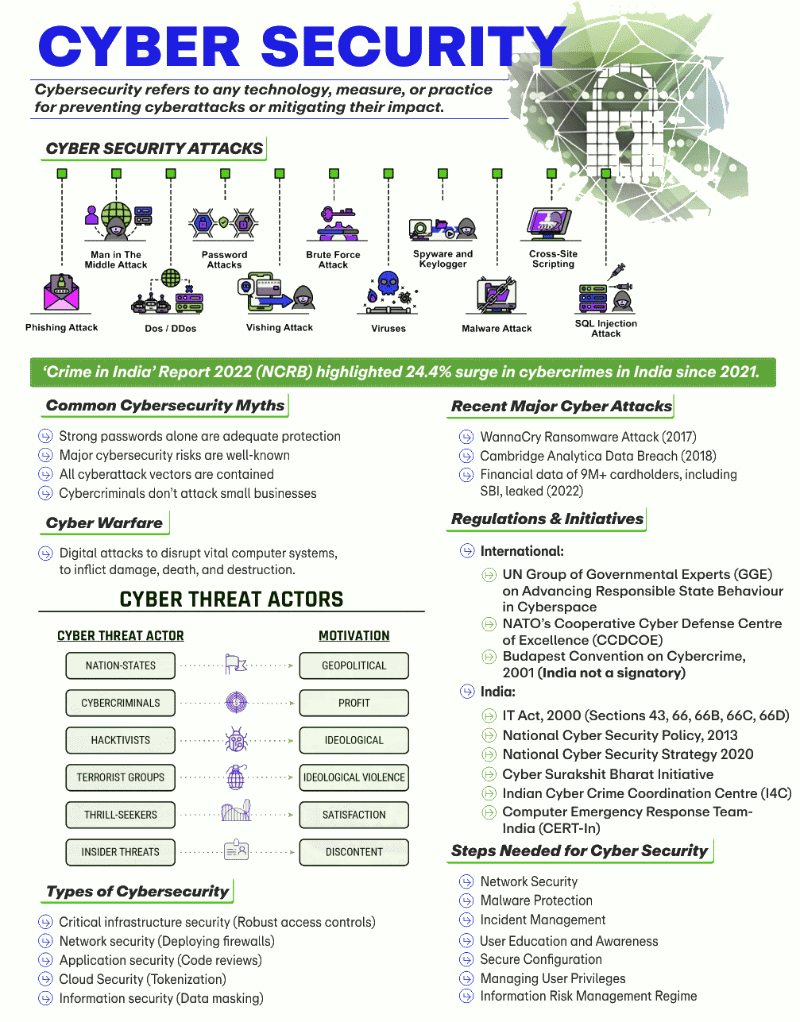
What is Non-Alcoholic Fatty Liver Disease (NAFLD)?
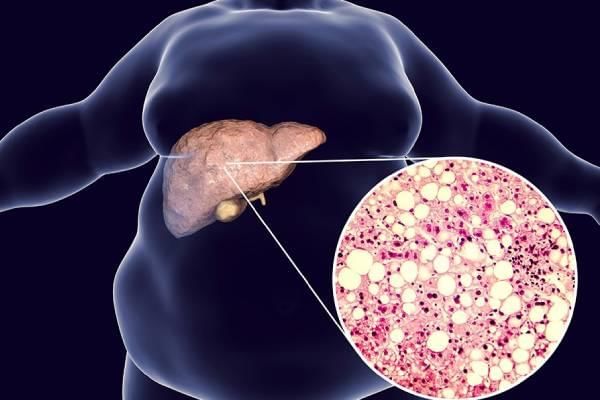 Why in News?
Why in News?
Ranchi is poised to be the first district in Jharkhand to launch a widespread initiative aimed at the screening and management of Non-Alcoholic Fatty Liver Disease (NAFLD).
Key Takeaways
- NAFLD, also known as Metabolic Dysfunction-Associated Steatotic Liver Disease (MASLD), refers to a spectrum of conditions arising from fat accumulation in the liver.
- This condition is distinct from alcohol-associated liver disease, as it occurs without heavy alcohol consumption.
- While early-stage NAFLD is typically harmless, it can progress to severe liver damage, including cirrhosis and liver cancer.
- NAFLD is linked to increased risks of other serious health issues like diabetes and high blood pressure.
Additional Details
- Types of NAFLD:There are two main forms:
- Nonalcoholic Fatty Liver (NAFL): Generally less severe.
- Nonalcoholic Steatohepatitis (NASH): A more severe form that can lead to cirrhosis and liver failure.
- Individuals at higher risk include those with conditions such as obesity and type 2 diabetes; NAFLD can also affect individuals of all ages, including children.
- Treatment Options: Currently, there is no specific medication for NAFLD. The primary recommendation is weight loss, which can help reduce liver fat, inflammation, and fibrosis.
- Management of associated conditions such as high blood pressure, diabetes, and cholesterol is also essential.
In conclusion, Non-Alcoholic Fatty Liver Disease is a significant health concern that requires awareness and proactive management to prevent progression to more severe liver conditions.
ISRO’s SpaDeX
Why in News?
The Indian Space Research Organisation (ISRO) is poised to reach a significant milestone with the launch of the Space Docking Experiment (SpaDeX) mission scheduled for 30 December 2024. This mission aims to demonstrate satellite docking capabilities, which are essential for future space missions.

Key Takeaways
- SpaDeX is a technology demonstrator mission by ISRO focused on in-space docking technology.
- The mission will involve two small spacecraft, SDX01 (Chaser) and SDX02 (Target), docking autonomously in low Earth orbit.
- It aims to enhance India's space capabilities and support future missions like Chandrayaan-4 and India's planned Bharatiya Antariksh Station (BAS).
Additional Details
- SpaDeX Mission Overview: The SpaDeX mission will deploy SDX01 and SDX02 into a 470 km orbit using the Polar Satellite Launch Vehicle (PSLV). These satellites will initially drift apart before approaching each other to dock within a distance of 20 km to 3 meters.
- Bharatiya Docking System (BDS): Both spacecraft will be equipped with the BDS, featuring identical, low-impact docking mechanisms that facilitate flexibility and precision for future operations such as satellite servicing and crew transfers.
- The mission will utilize PSLV's fourth stage, POEM (PSLV Orbital Experimental Module)-4, to carry 24 payloads from academic institutions and startups, taking advantage of the microgravity environment.
- During the docking maneuver, SDX01 and SDX02 will orbit at speeds of 28,800 km/h and must carefully reduce their relative velocity to just 0.036 km/h before successfully docking.
The development of docking technology through SpaDeX is crucial for constructing modular space infrastructure, enabling interplanetary missions, and enhancing India's presence in global space exploration. This technology not only supports operational longevity of satellites through servicing but also positions India among the leading nations capable of advanced space operations.
NASA's Parker Solar Probe
 Why in News?
Why in News?
The Parker Solar Probe has recently made history by flying closer to the Sun than any other human-made object. It achieved incredible speeds of 430,000 mph and endured extreme temperatures reaching up to 982°C.
Key Takeaways
- Launched in 2018, the Parker Solar Probe is a robotic spacecraft about the size of a car.
- It is named after Eugene Newman Parker, an American solar astrophysicist.
- This mission is notable as it is the first to be named after a living researcher.
- The Probe aims to explore regions within 3.8 million miles of the Sun's corona.
- It utilizes an advanced carbon-composite heat shield to survive extreme solar conditions.
Additional Details
- Mission Objectives:The Parker Solar Probe has several key objectives, including:
- Approaching within 6.5 million kilometers of the Sun to study energy flow and solar corona heating.
- Investigating the source of solar winds, which are high-speed streams of charged particles that impact space weather.
- Exploring the Sun's corona to understand why it is hotter than the Sun's surface, a longstanding question in astrophysics.
- Determining the structure and dynamics of the plasma and magnetic fields at the origins of solar winds.
- Examining the mechanisms that accelerate and transport energetic particles.
- The Parker Solar Probe represents a significant advancement in our understanding of solar phenomena.
In summary, the Parker Solar Probe is a groundbreaking mission that aims to unravel the mysteries of the Sun and its effects on the solar system, enhancing our understanding of solar dynamics and their implications for space weather.
Mitochondrial DNA Mutations and Age-Related Muscle Loss
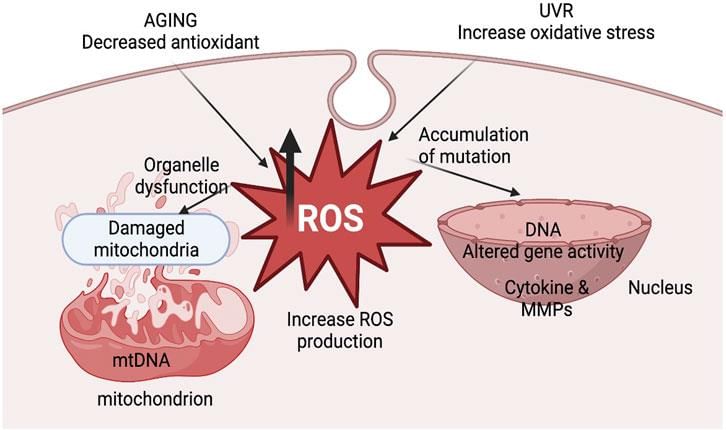 Why in News?
Why in News?
A recent study published in Genome Research emphasizes the significant role of deletion mutations in mitochondrial DNA (mtDNA) in contributing to age-related muscle loss.
Key Takeaways
- Deletion mutations in mtDNA affect mitochondrial efficiency and ATP production.
- Older individuals show a notable increase in chimeric mitochondrial mRNA, linked to biological aging.
- Understanding mtDNA mutations could lead to therapies to prevent age-related muscle loss.
Additional Details
- Mitochondria: These are membrane-bound organelles often referred to as the 'powerhouses' of the cell, crucial for energy production through the generation of adenosine triphosphate (ATP).
- Maternal Inheritance: Mitochondria are inherited exclusively from the mother via the egg cell, which has implications for genetic studies and inheritance patterns.
- Key Functions:
- Energy production: Mitochondria are responsible for generating ATP necessary for muscle contraction, protein synthesis, and cell division.
- Cellular respiration: They facilitate the conversion of food into usable energy.
- Regulating cell death: Mitochondria play a role in controlling apoptosis, maintaining healthy tissues.
- Key Findings of the Study:
- Deletion mutations in mtDNA reduce its size and functionality, leading to decreased mitochondrial efficiency.
- These mutations can produce chimeric genes that disrupt mtDNA expression, accelerating muscle degradation.
- Older individuals have a two-fold increase in chimeric mitochondrial mRNA, correlating with biological aging.
- Biomarkers for Biological Aging: mtDNA deletion mutations and chimeric mRNA serve as key indicators of biological aging, potentially guiding future therapeutic approaches.
Understanding the implications of mitochondrial DNA mutations is crucial for developing strategies to mitigate age-related muscle loss, thereby enhancing quality of life in the aging population.
Observation of a Smaller Black Hole in a Pair
Context
An international team of 32 scientists from 10 countries has made a groundbreaking discovery by observing a smaller black hole orbiting a larger one in the distant galaxy OJ 287. This marks the first direct observation of such a phenomenon. DetailsBackground
- Galaxy OJ 287: Located 4 billion light-years away, OJ 287 has been studied for its unique pair of black holes.
- Initial Theory: The idea of two black holes in OJ 287 was first suggested by astronomers at the University of Turku, Finland.
- NASA's TESS: In 2021, NASA's Transiting Exoplanet Survey Satellite (TESS), originally designed to find exoplanets, was directed towards OJ 287 to help confirm the black hole pair theory.
Key Findings
- Indirect Evidence: Earlier studies indicated a massive black hole orbiting a giant black hole 100 times its size.
- Direct Observation: TESS observed the brightness of the primary black hole and its jet, detecting a flare that suggested the presence of the smaller black hole.
- Accretion Disk Interaction: The flare was produced when the smaller black hole interacted with the accretion disk of the larger black hole, resulting in a bright jet of gas.
- Color Change: The jet's brightness caused a temporary shift in OJ 287's color from red to yellow.
- Future Prospects: The smaller black hole is anticipated to emit nano-Hertz gravitational waves, which could be detected by pulsar timing arrays in the near future.
Key Information About Galaxies
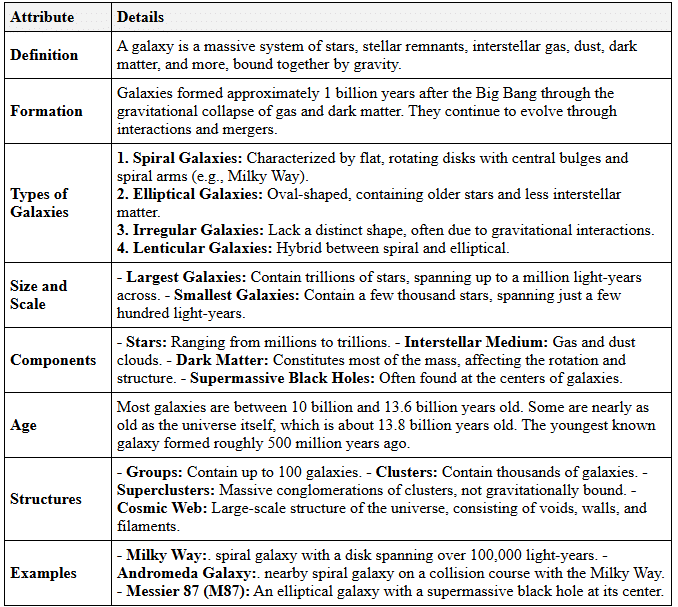
Impact of mtDNA Mutations on Age-Related Muscle Loss
- A recent study published in Genome Research highlights that deletion mutations in mitochondrial DNA (mtDNA) play a significant role in age-related muscle loss.
What are Mitochondria?
- Definition: Mitochondria are membrane-bound organelles present in the cytoplasm of most eukaryotic cells, often called the "powerhouses" of the cell.
- Maternal inheritance: Mitochondria are inherited exclusively from the mother via the egg cell.
- Energy production: Generate adenosine triphosphate (ATP), the primary energy carrier required for muscle contraction, protein synthesis, and cell division.
- Cellular respiration: Facilitates the breakdown of food into energy in the form of ATP.
- Regulating cell death: Control apoptosis, ensuring the maintenance of healthy tissues.
Mitochondrial DNA (mtDNA): Contains its DNA, which is prone to mutations that significantly affect cellular functions.
Key Findings of the Study
- Deletion mutation's role: Deletion mutations in mtDNA reduce its size and functionality, gradually eroding mitochondrial efficiency.
- These mutated mtDNA molecules outcompete healthy ones, leading to a decline in ATP production.
- Chimeric genes: Deletion mutations create chimeric genes by fusing different mitochondrial genes, forming abnormal sequences.
- Chimeric genes disrupt mtDNA expression, accelerating mitochondrial dysfunction and muscle degradation.
- Age-related changes: Older individuals exhibit a two-fold increase in chimeric mitochondrial mRNA, correlating with biological ageing.
- Mutations also affect brain and muscle tissues, emphasizing their systemic impact on ageing.
- Biomarkers for biological ageing: mtDNA deletion mutations and chimeric mRNA are key indicators of biological ageing.
- Understanding these markers could pave the way for therapies to prevent or repair mutations, delaying age-related muscle loss.
Subclinical TB
Why in the news?
During a recent meeting at the Health Ministry, the difficulties in identifying subclinical TB cases and ensuring their proper treatment were emphasized.
What is Subclinical TB?
- Definition: Subclinical TB refers to instances where a person is infected with tuberculosis (TB) but does not exhibit the usual symptoms associated with the disease.
- Causal Agent: The condition is caused by viable Mycobacterium tuberculosis bacteria.
- Traits: Subclinical TB includes cases that are culture-positive but lack typical TB symptoms, such as:
- Persistent Cough: No persistent cough or cough at all.
- Symptom Absence: Absence of TB-suggestive symptoms like cough, chest pain, fever, night sweats, or weight loss.
Despite global efforts, tuberculosis (TB) poses a significant public health challenge. In 2022, there were 7.5 million new TB cases worldwide, resulting in 1.3 million deaths, even after the UN's resolution to eradicate TB by 2035.
- Spread: The national TB prevalence survey conducted between 2019 and 2021 revealed that 42.6% of detected TB cases were subclinical, which would have been overlooked without chest X-ray screening.
- Tamil Nadu's TB survey indicated a 39% prevalence of subclinical TB cases.
- Subclinical cases represent a substantial portion of TB infections, with up to 82.7% lacking a persistent cough.
- Silent Infection Source: Subclinical TB can result in diagnostic delays and ongoing transmission.
- Approximately 29% of individuals without a persistent cough and 23% without any cough are still smear-positive, indicating the potential for transmission.
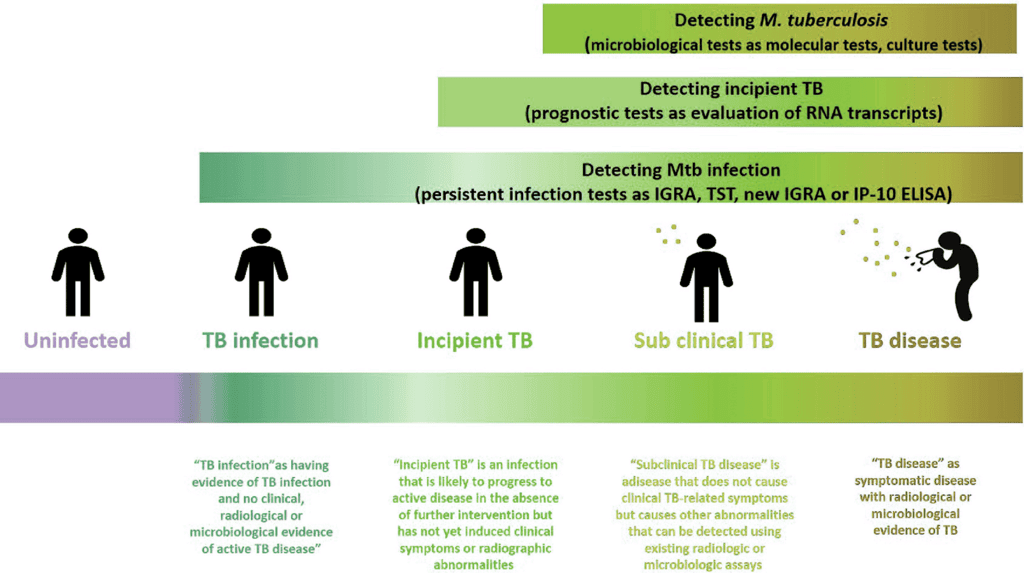
What are the major challenges of Subclinical TB?
- Vulnerability: High-burden states in India are expected to have a significant prevalence of subclinical TB, with countries showing a median of 50% subclinical TB cases.
- Asymptomatic Nature: The asymptomatic nature of subclinical TB makes it challenging to identify and diagnose through routine screenings.
- Delayed Diagnosis: Delayed diagnosis leads to longer diagnostic delays, allowing the disease to progress and increasing the risk of transmission.
- Detection Gaps: Traditional diagnostic methods, such as sputum tests and symptom-based screening, may overlook subclinical cases, particularly in areas with limited healthcare resources.
- Scaling Challenges: Implementing widespread chest X-ray screening poses challenges, requiring mobile units and regular community screenings.
- Underreporting: For every notified TB case, there are potentially two undetected cases with culture-positive TB, hindering progress in reducing TB incidence.
- Patient Compliance: Convincing asymptomatic individuals to initiate and complete a six-month treatment regimen is difficult, leading to higher dropout rates despite potentially better outcomes. Incomplete treatment increases the risks of drug resistance and treatment failure.
What lies ahead?
- AI-based Screening: Implement AI-driven chest X-ray screening to enhance TB detection efficiency.
- Drug Supply and Human Resources: Ensure a consistent supply of medications and scale up human resources for TB management.
- Active Case Finding: Utilize mobile vans, computer-aided radiology, and rapid molecular tests for active case-finding initiatives.
- Symptom Definition Update: Broaden the definition of TB-suggestive symptoms to include a wider range of indicators (e.g., any cough, weight loss, night sweats) for improved early detection.
- Community Education: Raise awareness in communities about the risks associated with subclinical TB and the importance of early detection and treatment.
- Digital Adherence Tools: Utilize digital tools to ensure patients with subclinical TB complete their treatment regimens.
- Research on Treatment Regimens: Conduct research to develop and validate shorter, more effective treatment regimens tailored specifically for subclinical TB cases.
- Vietnam's Success: Learn from Vietnam's successful reduction of TB prevalence by 50% in certain areas through annual population-wide symptom-agnostic screening (X-rays and molecular tests).
|
38 videos|5293 docs|1118 tests
|
FAQs on Science and Technology - 4 - Current Affairs & Hindu Analysis: Daily, Weekly & Monthly - UPSC
| 1. What is ISRO's SpaDeX mission, and what are its objectives? |  |
| 2. How does NASA's Parker Solar Probe contribute to our understanding of the Sun? |  |
| 3. What role do mitochondrial DNA mutations play in age-related muscle loss? |  |
| 4. Are there any preventive measures to reduce the impact of space debris on satellites? |  |
| 5. What are the implications of findings from the Parker Solar Probe for Earth-based technology? |  |
















